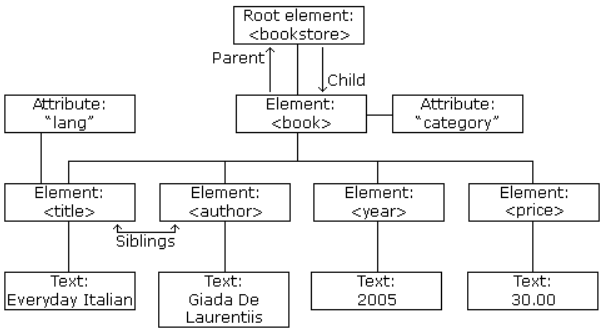XML Tree Structure
An XML document has a self-descriptive structure. It forms a tree structure which is referred as an XML tree. The tree structure makes easy to describe an XML document.
A tree structure contains root element (as parent), child element and so on. It is very easy to traverse all succeeding branches and sub-branches and leaf nodes starting from the root.
Example
Example: Bookstore
<?xml version="1.0" encoding="UTF-8"?>
<bookstore>
<book category="cooking">
<title lang="en">Everyday Italian</title>
<author>Giada De Laurentiis</author>
<year>2005</year>
<price>30.00</price>
</book>
<book category="children">
<title lang="en">Harry Potter</title>
<author>J K. Rowling</author>
<year>2005</year>
<price>29.99</price>
</book>
<book category="web">
<title lang="en">Learning XML</title>
<author>Erik T. Ray</author>
<year>2003</year>
<price>39.95</price>
</book>
</bookstore>
Represented graphically in the following image

XML Tree Structure
XML documents are formed as element trees.
An XML tree starts at a root element and branches from the root to child elements.
All elements can have sub elements (child elements):
<root>
<child>
<subchild>...</subchild>
</child>
</root>
The terms parent, child, and sibling are used to describe the relationships between elements.
Parents have children. Children have parents. Siblings are children on the same level (brothers and sisters).
All elements can have text content and attributes.
Self-Describing Syntax
XML uses a much self-describing syntax.
A prolog defines the XML version and the character encoding:
<?xml version="1.0" encoding="UTF-8"?>
The next line starts a <book> element:
<book category="cooking">
The <book> elements have 4 child elements: <title>, <author>, <year>, <price>.
<title lang="en">Everyday Italian</title>
<author>Giada De Laurentiis</author>
<year>2005</year>
<price>30.00</price>
The next line ends the book element:
</book>